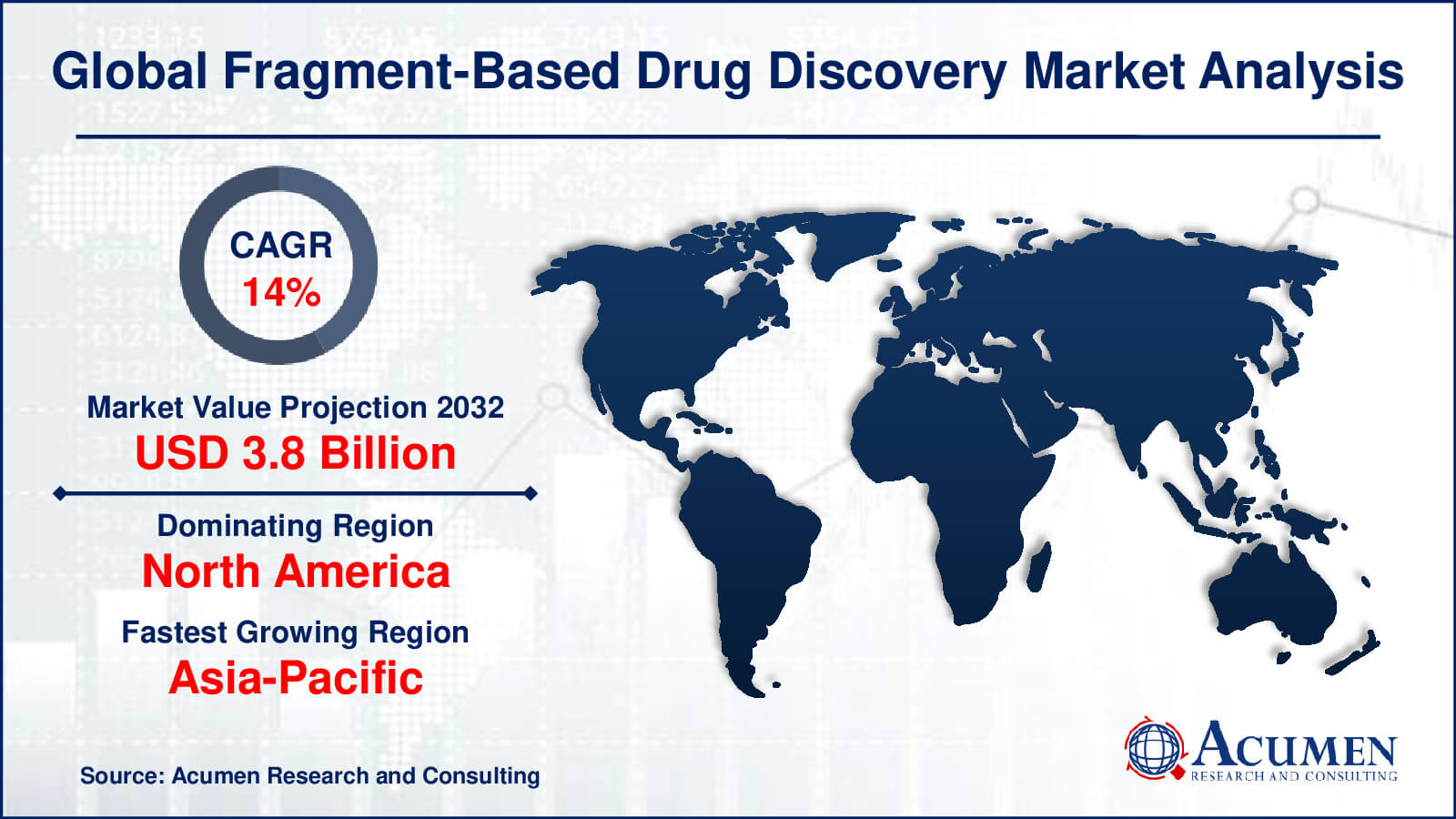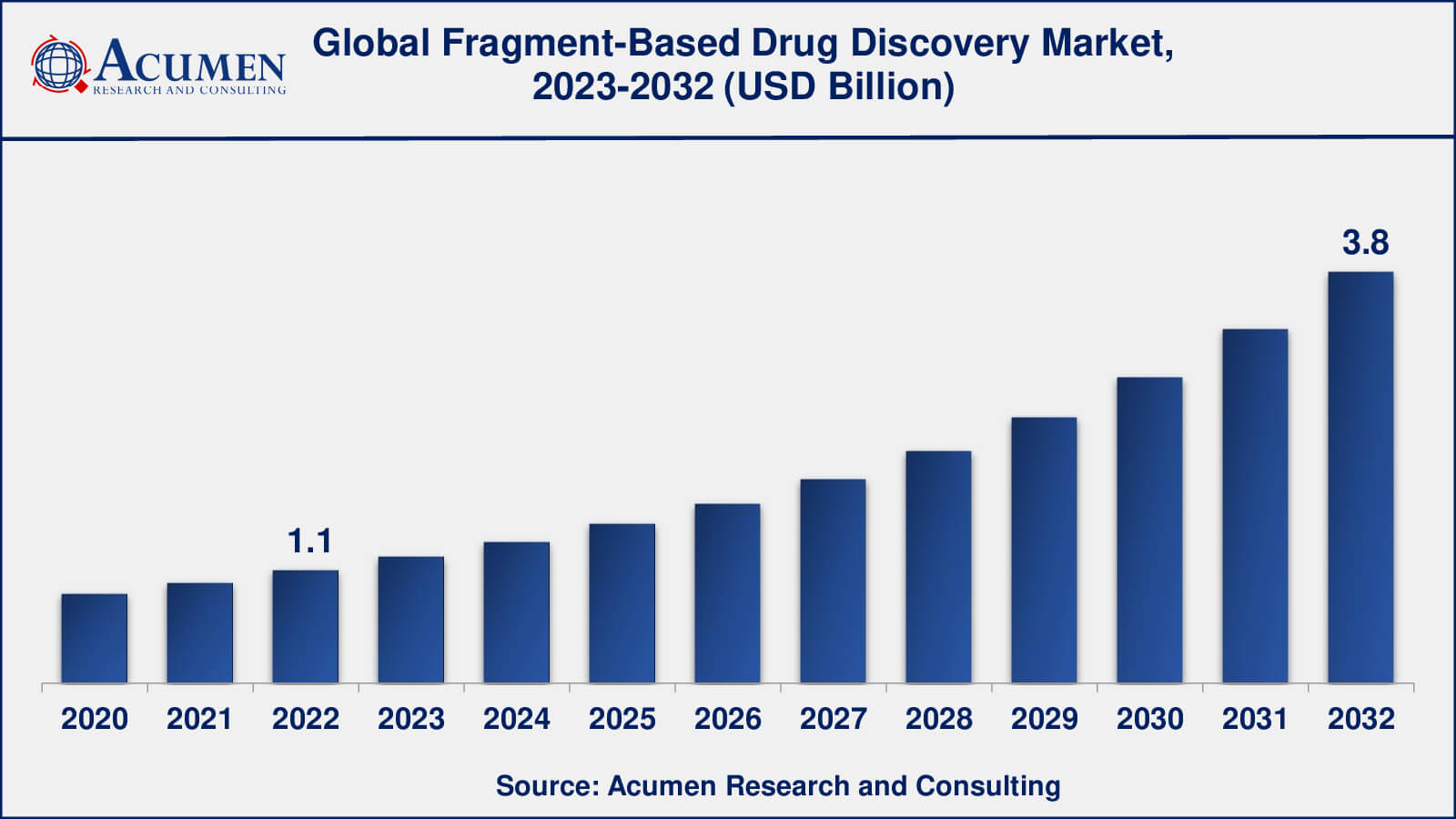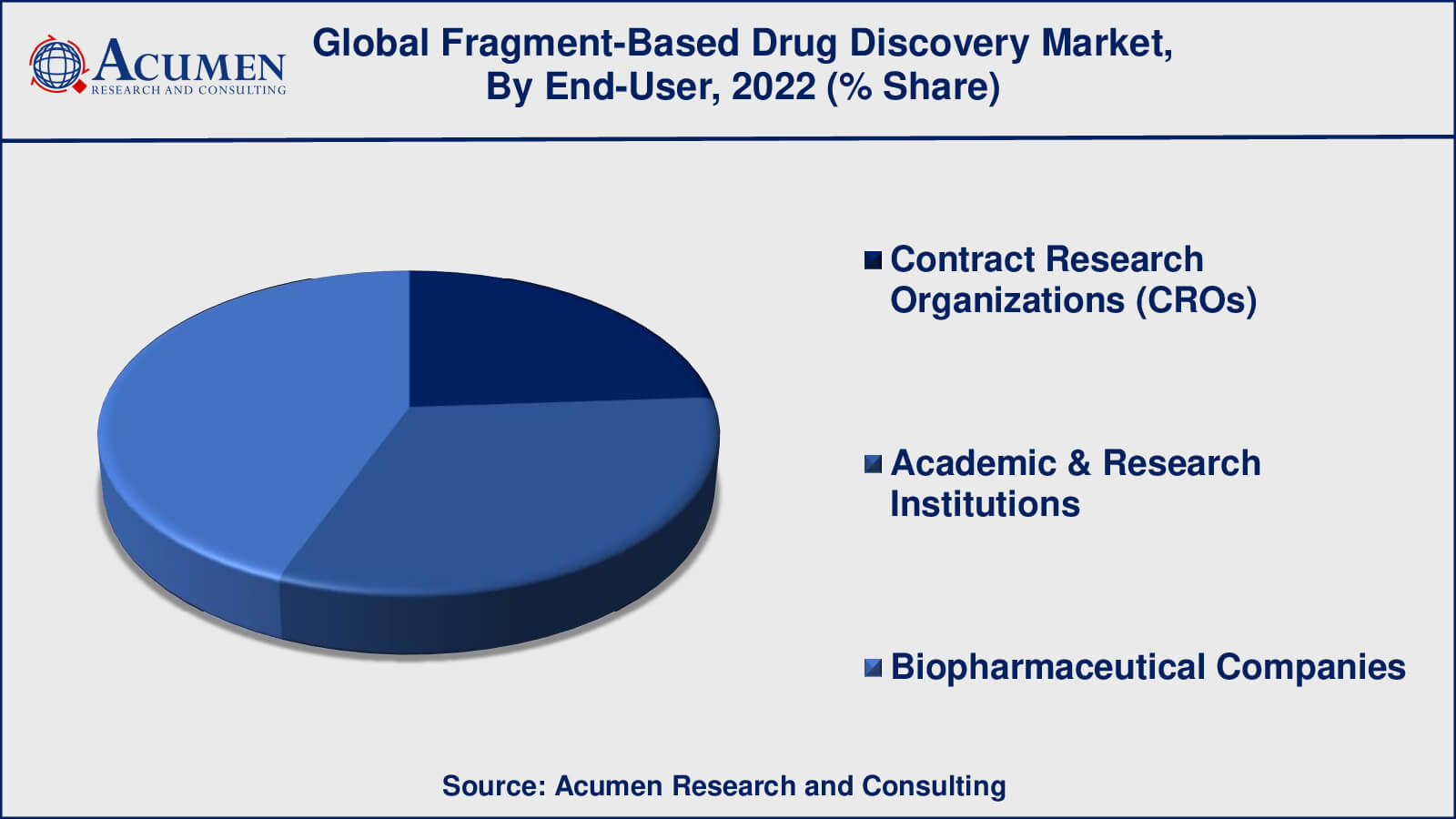Fragment-Based Drug Discovery Market Size - Global Industry, Share, Analysis, Trends and Forecast 2023 - 2032
Published :
Report ID:
Pages :
Format :
Fragment-Based Drug Discovery Market Size - Global Industry, Share, Analysis, Trends and Forecast 2023 - 2032
Report Coverage
- Industry Dynamics
- Market Size and Forecast Data
- Segment Analysis
- Competitive Landscape
- Regional Analysis with a Niche Focus on Country-Level Data
- High Level Analysis - Porter's, PESTEL, Value Chain, etc.
- Company Profiles of Key Players
- Option to Customize the Report As Per Your Specific Need
Request Sample Report
The Global Fragment-Based Drug Discovery Market Size accounted for USD 1.1 Billion in 2022 and is estimated to achieve a market size of USD 3.8 Billion by 2032 growing at a CAGR of 14.0% from 2023 to 2032.
Fragment-Based Drug Discovery Market Highlights
- Global fragment-based drug discovery (FBDD) market revenue is poised to garner USD 3.8 billion by 2032 with a CAGR of 14.0% from 2023 to 2032
- North America fragment-based drug discovery market value occupied more than USD 420 million in 2022
- Asia-Pacific fragment-based drug discovery market growth will record a CAGR of over 14% from 2023 to 2032
- Among technique, the x-crystallography sub-segment generated around US$ 399 million revenue in 2022
- Based end-user, the biopharmaceutical companies sub-segment generated around 45% share in 2022
- Growing interest in natural products is popular fragment-based drug discovery market trends that fuels the industry demand

Fragment-based drug discovery (FBDD) also called fragment-based lead recovery, is a measure to find lead compounds in the drug discovery process. The process is based on the identification of small chemical fragments that may not strongly bind to the biological target and combining or growing them in order to produce a lead that has higher similarity. The growing exploration of new drugs for the treatment of complex medical problems is the major factor leading to the increasing demand for the fragment-based drug discovery market. Additionally, the market for fragment-based drug discovery has also resulted in the domination of biopharmaceutical companies since the market is in need of a system that helps in the discovery of lead compounds during the procedure of drug discovery.

Global Fragment-Based Drug Discovery Market Dynamics
Market Drivers
- Increasing demand for new drugs
- Collaboration between academia and industry
- Rising prevalence of chronic diseases
- Cost and time efficiency
Market Restraints
- High cost of FBDD
- Limited research and development
- Legal and ethical challenges
Market Opportunities
- Increased focus on protein-protein interactions
- Emergence of new FBDD technologies
- Focus on rare and neglected diseases
Fragment-Based Drug Discovery Market Report Coverage
| Market | Fragment-Based Drug Discovery Market |
| Fragment-Based Drug Discovery Market Size 2022 | USD 1.1 Billion |
| Fragment-Based Drug Discovery Market Forecast 2032 | USD 3.8 Billion |
| Fragment-Based Drug Discovery Market CAGR During 2023 - 2032 | 14.0% |
| Fragment-Based Drug Discovery Market Analysis Period | 2020 - 2032 |
| Fragment-Based Drug Discovery Market Base Year | 2022 |
| Fragment-Based Drug Discovery Market Forecast Data | 2023 - 2032 |
| Segments Covered | By Type, By Technique, By End-User, And By Geography |
| Regional Scope | North America, Europe, Asia Pacific, Latin America, and Middle East & Africa |
| Key Companies Profiled | Alveus Pharmaceuticals Pvt. Ltd., Astex Pharmaceuticals, Charles River Laboratories International, Inc., Beactica AB, Emerald BioStructures, Inc., Crown Bioscience, Inc., Evotec AG, Proteros Fragments GmbH, Kinetic Discovery Limited, Sprint Bioscience, Sygnature Discovery and Structure Based Design, Inc. |
| Report Coverage |
Market Trends, Drivers, Restraints, Competitive Analysis, Player Profiling, Covid-19 Analysis, Regulation Analysis |
Fragment-Based Drug Discovery Market Insights
The time-saving characteristics and prompt access to techniques related to biophysical fragment screening are the essential drivers of the global fragment-based drug discovery market. The fragment-based drug discovery has emerged as a measure to design unique molecules. This system uses smaller ligands or fragments that consist of lower molecule weight. However, the weak potency of some compounds which are the result of fragment screening and the requirement of specific fragment libraries in order to conduct research are some of the key factors hindering the fragment-based drug discovery market growth.

Fragment-Based Drug Discovery Market Segmentation
The worldwide market for fragment-based drug discovery is split based on type, technique, end-user, and geography.
FBDD Market Types
- Library Screening
- Fragment Screening
- Fragment Optimization
According to the fragment-based drug discovery industry analysis, fragment screening is currently the most dominant type in the FBDD market. Typically, fragment-based drug discovery involves screening small, low molecular weight compounds, known as fragments, for their ability to bind to a target protein. This can be accomplished through either library screening, which involves screening larger libraries of compounds for binding, or fragment screening, which involves screening smaller, more focused libraries of fragments.
Fragment screening has grown in popularity in recent years due to its ability to identify high-quality lead compounds with optimal binding properties, which can then be further optimised using fragment optimization techniques to improve drug-like properties. In general, fragment screening is more efficient and cost-effective than library screening because it allows for a more focused approach to identifying hits.
While library screening is still extensively used in drug discovery, fragment screening has grown in popularity due to its benefits and is expected to dominate the FBDD market in the coming years.
FBDD Market Techniques
- X-Ray Crystallography
- Nuclear Magnetic Resonance
- Surface Plasmon Resonance
- Other Screening Techniques

In FBDD, X-ray crystallography is widely used and is regarded as the gold standard for determining the three-dimensional structure of proteins and their ligand complexes. Because of its high resolution and ability to determine the atomic structure of ligands bound to proteins, X-ray crystallography is an essential tool for fragment-based drug design.
Nuclear magnetic resonance (NMR) is another technique used in FBDD that can provide useful information about the binding interactions of a protein and its ligands in solution. NMR is useful for identifying weakly binding fragments and can provide insight into protein dynamics.
Surface plasmon resonance (SPR) is a label-free method for measuring in real-time the binding interactions between proteins and their ligands. SPR can provide information about binding affinity and specificity and is useful for studying the kinetics of protein-ligand interactions.
FBDD Market End-Users
- Contract Research Organizations (CROs)
- Academic & Research Institutions
- Biopharmaceutical Companies

According to the fragment-based drug discovery market forecast, the biopharmaceutical companies are expected to lead the market in the coming years. Due to the high cost of drug development and the need for significant investment in research and development, biopharmaceutical companies are typically the largest end-users of FBDD. These companies frequently have the resources to run their own FBDD programmes or to collaborate with CROs to speed up the drug development process.
CROs accounted for the second-largest market share in the fragment-based drug discovery FBDD market. CROs are companies that provide biopharmaceutical companies and academic institutions with research and development services. CROs can provide FBDD and other drug discovery expertise, as well as access to specialised equipment and facilities. CROs are expected to play an increasingly important role in the FBDD market as demand for outsourced drug development services grows.
Fragment-Based Drug Discovery Market Regional Outlook
North America
- U.S.
- Canada
Europe
- U.K.
- Germany
- France
- Spain
- Rest of Europe
Asia-Pacific
- India
- Japan
- China
- Australia
- South Korea
- Rest of Asia-Pacific
Latin America
- Brazil
- Mexico
- Rest of Latin America
The Middle East & Africa
- South Africa
- GCC Countries
- Rest of the Middle East & Africa (ME&A)
Fragment-Based Drug Discovery Market Regional Analysis
The geography segment includes North America, Asia-Pacific, Latin America, Europe, and Middle East & Africa (MEA). North America is dominating the fragment-based drug discovery market and is anticipated to continue its dominance over the coming years. The factors responsible for North America’s dominance include high investments by the key players in the research & development of fragment-based drug discovery, advanced and developed infrastructure, and healthcare systems in the US and Canada. Also, nations are often considered the base for implementing technology advancements. The North American region is continuously focusing on the development of techniques regarding fragment-based drug discovery by making use of outsourcing Asia-Pacific’s facilities. However, the demand in Asia-Pacific is growing at a very high pace in comparison to other regions, attributed to continuous investments in healthcare infrastructure and increasing focus on improving quality management, particularly in China and Japan.
Fragment-based drug discovery systems have developed considerably in popularity recently and have emerged as a great scope in the field of biopharmaceuticals. This consists of large companies, CROs, and academic bodies. These systems have facilitated essential in creating of chemical series which have lead-like properties as these have enhanced the success rate of creation more importantly than the conventional screening systems. Also, fragment-based drug discovery systems have been proven to be extremely useful in marking out chemical series from multiple targets.
Fragment-Based Drug Discovery Market Players
Some of the top fragment-based drug discovery companies offered in the professional report include Alveus Pharmaceuticals Pvt. Ltd., Astex Pharmaceuticals, Charles River Laboratories International, Inc., Beactica AB, Emerald BioStructures, Inc., Crown Bioscience, Inc., Evotec AG, Proteros Fragments GmbH, Kinetic Discovery Limited, Sprint Bioscience, Sygnature Discovery and Structure Based Design, Inc.
Frequently Asked Questions
What was the market size of the global fragment-based drug discovery in 2022?
The market size of fragment-based drug discovery was USD 1.1 billion in 2022.
What is the CAGR of the global fragment-based drug discovery (FBDD) market from 2023 to 2032?
The CAGR of fragment-based drug discovery is 14.0% during the analysis period of 2023 to 2032.
Which are the key players in the fragment-based drug discovery (FBDD) market?
The key players operating in the global market are including Alveus Pharmaceuticals Pvt. Ltd., Astex Pharmaceuticals, Charles River Laboratories International, Inc., Beactica AB, Emerald BioStructures, Inc., Crown Bioscience, Inc., Evotec AG, Proteros Fragments GmbH, Kinetic Discovery Limited, Sprint Bioscience, Sygnature Discovery and Structure Based Design, Inc.
Which region dominated the global fragment-based drug discovery (FBDD) market share?
North America held the dominating position in fragment-based drug discovery industry during the analysis period of 2023 to 2032.
Which region registered fastest CAGR from 2023 to 2032?
Asia-Pacific region exhibited fastest growing CAGR for market of fragment-based drug discovery during the analysis period of 2023 to 2032.
What are the current trends and dynamics in the global fragment-based drug discovery industry?
The current trends and dynamics in the fragment-based drug discovery industry include increasing demand for new drugs, collaboration between academia and industry, and rising prevalence of chronic diseases.
Which type held the maximum share in 2022?
The fragment screening held the maximum share of the fragment-based drug discovery industry.


